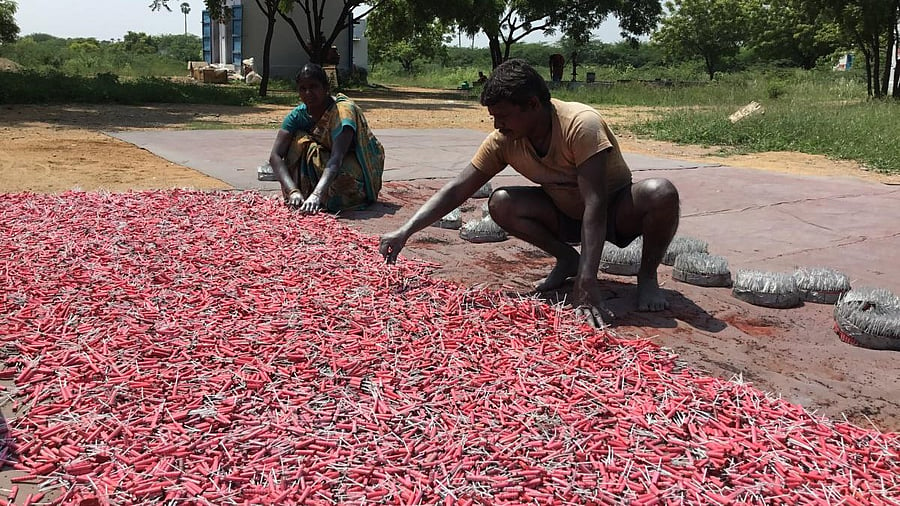
The fireworks factories in Sivakasi witnessed 236 accidents from 2014 till April 24 this year, resulting in the death of 291 people.
Credit: DH File Photo
The fireworks industry in Tamil Nadu’s Sivakasi, which manufactures about 90 per cent of India’s crackers, marked its centenary in 2023. The multi-crore industry has evolved over the past century by embracing technology and ensuring a smooth transition from conventional crackers to combination fireworks. However, one issue continues to plague the industry – fatal accidents at manufacturing units due to non-compliance with safety regulations. The fireworks factories in Sivakasi witnessed 236 accidents from 2014 till April 24 this year, resulting in the death of 291 people, with 204 others being injured.
With an annual turnover of about Rs 6,000 crore, the industry employs about three lakh people directly and another four lakh people indirectly, making it the single largest source of employment in the arid Virudhunagar district.
The industry faced allegations of employing child labour for decades and suffered a blow in 2018 when the Supreme Court banned barium nitrate, a chemical deemed essential. However, it is transitioning to manufacturing green crackers, though teething problems persist.
Of Tamil Nadu’s 1,482 fireworks factories, 1,085 operate in and around Sivakasi, known as ‘Little Japan’, for its skilled workforce. Hundreds of thousands of labourers, 55 per cent of whom are women, painstakingly produce crackers by hand without machines for eight to nine months a year.
P Ganesan, the president of the Sivakasi-based Tamil Nadu Fireworks and Amorces Manufacturers Association (TANFAMA), told DH that the number of accidents and fatalities in fireworks factories has remained stable since the 1980s, despite a 15-fold increase in the number of manufacturing units.
DH Infographics
“One of the greatest achievements is the transition from conventional fireworks like flowerpots, sparklers, and crackers to combination (fancy) fireworks,” Ganesan said. “These new varieties use a significantly lower quantity of chemicals, making the fireworks not only more vibrant and enjoyable but also contributing to a reduction in accidents.”
Ganesan said that the annual number of accidents, ranging from 1 to 10, including natural disasters, had remained consistent over decades, even as the industry expanded. “The use of technology and the unwavering commitment of both industry and officials have played a major role in ensuring safety.”
“Self-discipline is crucial in fireworks factories and must never be compromised,” he said, emphasising strict adherence to safety norms and regulations.
Another leading fireworks manufacturer noted a dramatic increase in the number of cracker varieties offered by companies. “Today, every major player offers around 450 to 500 variants. That’s a key milestone for our industry. Despite being unfairly labelled as polluters, we ensure eco-friendly practices both in manufacturing and usage,” he added.
Sources in the Industrial Safety Department told DH that committees investigating accidents over the past decade concluded that 80 per cent of mishaps in fireworks factories were caused by human error.
“Most accidents occur in mixing and filling rooms where chemicals are mixed. Mishandling chemicals, causing static electricity or friction, can trigger a blast. These highly sensitive chemicals require careful handling,” a senior official said.
Major accident causes include gross violations of Standard Operating Procedures (SOPs), use of excessive chemicals, and recruitment of more workers than permitted.
“Only two people are permitted in the mixing and filling room, but many factories violate this rule, with more people often found inside or nearby. In case of a blast, the force is so strong that even a small stone hitting a person could be fatal,” another official added.
In addition to conducting regular factory inspections, the district administration has mandated training for foremen and chemical handlers to renew licenses. “If they are adequately trained, we can minimise accidents,” a district official added.